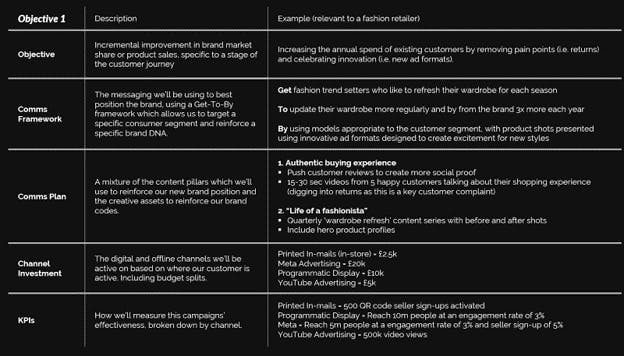New Year Marketing Planning: our ‘Find, Fix & Deliver’ Framework
As we push into Q4 most businesses are looking forward to the new calendar year by defining their marketing goals, strategies and budgets, hungry to deliver results that are an improvement on the year just gone. Depending on what stage you are in your career, creating marketing plans will either be an exciting new challenge or feel more like an albatross around your neck. Whether this is your first or fifteenth attempt, here we’ll introduce an effective framework to ensure your next annual plans have a solid structure that impresses your bosses and gives you the best chance of success.
Introducing the Find, Fix, Deliver framework:
- Find - find out exactly what is stopping you from growing
- Fix - implement the necessary changes across every layer of the business
- Deliver - embed this into your marketing execution
Step 1 - FIND
Before diving head first into planning it is important to zoom out and establish your goals. Here we’re not simply talking about revenue or profit growth. Yes that’s the ultimate outcome of any solid marketing plan, but we can be smarter than this. OKRs (Objectives and Key Results) are a good place to start. This teaches you that while revenue or sales growth are your primary Objective, what you need to find is your Key Results. These are leading indicators which, when performing well, will help you increase sales or revenue. Examples of Key Results include:
- New customer acquisition
- Customer churn rate
- Brand market share
- Ecommerce store Traffic
- Basket value growth
- ROAS
Really think about which metrics matter most to your business. For more help on this, check out John Doerr’s excellent teachings on Metrics That Matter.
Once you have clarity on your goals, you’re ready to find why you’re struggling to hit these. Here you can’t look past a TOWS analysis, a popular alternative to the classic SWOT:
- Threats & Opportunities - firstly, do not look inward to your brand but outward to the wider market. This is a crucial step many marketers overlook! What threats and opportunities exist within your landscape? At this point feel free to think big and abstract about what’s happening in your category. How are buying behaviours changing? Are younger consumers entering the market? Any new competitors entering the space, whether direct or indirect? Is all of the above happening consistently across all international markets or is variance rife?
- Weaknesses & Strengths - secondly, assess what your brand’s genuine weaknesses & strengths are in relation to these. To do this effectively, be ready to get honest with yourself and your brand. In-house marketers spend 40 hours per week, 52 weeks per year, immersed in their own brand and ‘getting out the bubble’ can be hard. Ask for another perspective from somebody in your network. From there, you should have a view as to what you need to work on to compete and where you need to maximise to grow.
Marks & Spencer’s 2021 annual report is a great example of a brand who really got to the root of this ‘find it’ stage. The below slide showcases their detailed analysis and what you’ll notice is that these issues blend both internal and external, looking business wide. As marketers we can only succeed if we’re remaining competitive and what each of the below issues highlight is that M&S were struggling to keep pace.

While the above is a great example of how to communicate what you’ve found in an engaging way, we recommend creating a set of SMART objectives which are aligned to the Key Results you want to improve and are laser-focused to how you’re going to achieve.
Step 2 - FIX
Now that you’ve found what is stopping your growth time to put your plan together. Here’s what we’d recommend including:
- Objective - the 2-3 objectives you’ve identified above
- Communications Framework - the customer you’re targeting and the key brand or product messages you’d like to use
- Communication Plan - the content pillars that will act as the vehicle to deliver your message
- Channel Investment - the most effective channels and a napkin sketch of budgets
- KPIs - what success will look like for each channel
To see how this could look in practice, here’s an example we’ve used at s360 UK when working with a household fashion retailers for a small campaign:

To help put this together, here are our biggest pieces of advice:
- Fix issues. It’s easier to fix something broken than to create something new from a blank canvas. The ‘Fix’ part of this framework is all about removing friction and narrowing in on what’s stopping you from growing.
- Adopt a ‘less is more’ philosophy. Yes you’d like your marketing to 4 consumer segments across 10 digital channels, but how realistic is this? Do you have the resources, whether internal or in your agency agreements to deliver? Does this stretch your budget too thin? Good strategy is more about what you leave out than what you leave in.
- Get the buy-in from top-to bottom-of the business. To achieve big changes, you need to empower others to help you. For example, if M&S only upgraded their digital marketing but ignored the digitalisation of the in-store experience, they would still be behind the curve.
Step 3 - DELIVER
With a view of your goal and how you’ll get there, the last step is to deliver on your plans. There’s a lot of different considerations but over many years of creating marketing plans for international brands, here are favourites:
- Stick to the 60/40 rule - 60% brand building and 40% performance gives businesses the right balance for long-term success. Yes it might vary by 5-10% based on your brand salience and market size, but this ratio can be trusted and is based on lots of evidence-based analysis. If you would like more information about the importance of Brand & Performance marketing, read our article here.
- Think of your customer journey - new customer acquisition is always an appetising route for growth but not when it’s at the expense of retention. Keep in mind each stage of your customer journey and make sure you support the full journey. Note that your brands’ own journey might be 3 steps or 9 steps, it really depends how convoluted the buying experience is and how complex you want to make it.

- Be agile - Finally, whilst all this planning is a great base for success, you need to bake in a layer of flexibility. In an ever connected world all brands are subjected to the disruption of global events, whether that be war, AI or TikTok trends, this dynamic landscape is not something you can predict. If you’re then too slow to catch up to these changes, your brand reputation & performance could suffer as a consequence. Be ready to move budgets across channels or markets if the data is telling you too.
And with that, you’re ready to take the new year in your stride! Driving growth will not come from maintaining the same strategy and execution as last year, the landscape is getting more crowded, competitive and continually evolving. In order to keep pace, there’s a need to find those key areas which will deliver the best results, fix the biggest blockers to your growth and deliver your plan with confidence and flexibility. Good luck!
